
Life can be busy. Most of us do not have the time to spend hours and hours in our gardens each week. But a garden can be low maintenance and still be incredibly beautiful and productive.
With these 20 low maintenance garden tips, you can spend less time in your garden, while getting more out of it.
You might not have much time at all, but set aside a little time at the beginning to establish your garden and you won’t have to compromise. You can still grow at least some of your own food, and plenty of ornamental plants.
In fact, you might be amazed by just how much a low maintenance garden can give you.
No matter how large or small your garden may be, you will find that when you follow the tips below, you can create a flourishing and natural garden that, once established, more or less takes care of itself.
Learn From Nature
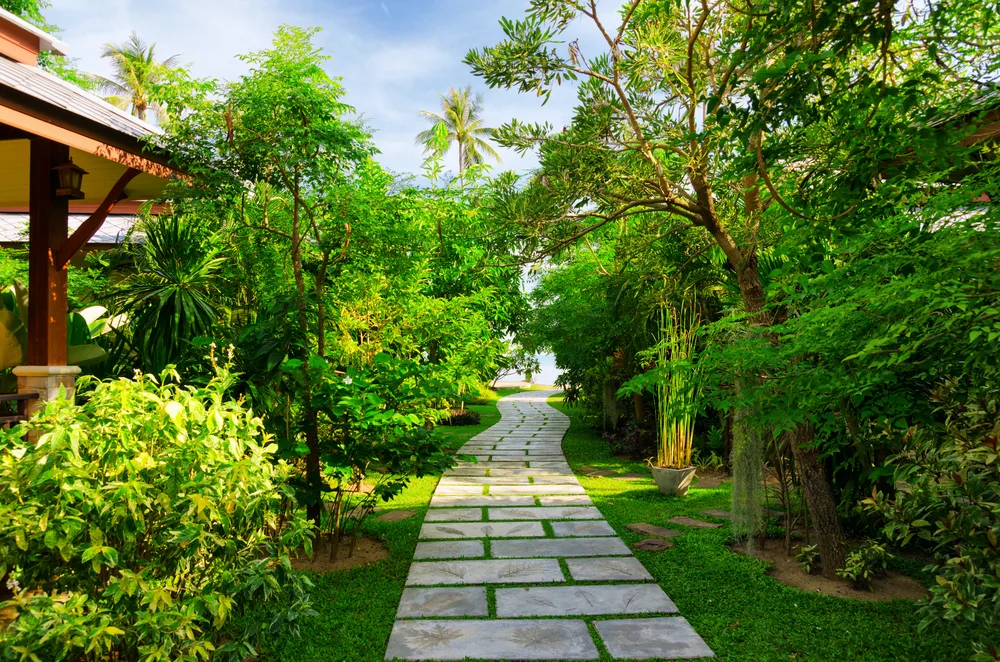
Nature is a great teacher. It effortlessly creates plant combinations and flourishing ecosystems that require no input from man. Here are some things we can learn from natural systems to create our low maintenance gardens:
1. Copy The Most Successful Ecosystems on Earth
The forest is one of the most successful ecosystems in the natural world.
These thriving ecosystems teem with life, above and below the soil. Forests are more than just collections of trees.
They are communities of plants and other organisms that all work together in a wide range of different ways.
But a forest does not necessarily produce the food that we may require from our gardens. So how can we take the idea of a forest and transfer it to our gardens?
Forest gardening offers an answer.
We can copy the diverse plants and the layers of vegetation, but replace the natural forest species with plants that are useful to us.
These plants may be useful to us directly, but may also be included to aid the system itself in some way.
A forest garden, therefore, has many of the characteristics of a natural forest, but is specifically tailored to meet our own needs. A forest garden can be a huge area, covered with diverse planting and hundreds of trees.
But the idea can also be scaled down to suit even the smallest of gardens.
Even if you only have space for one or two trees, the ideas of forest gardening can still be implemented. This is one of the top tips for creating an eco-friendly but low maintenance garden.
Once established, like a natural forest, a well-designed forest garden will pretty much take care of itself.
2. Avoid Bare Soil – Nature Abhors a Vacuum
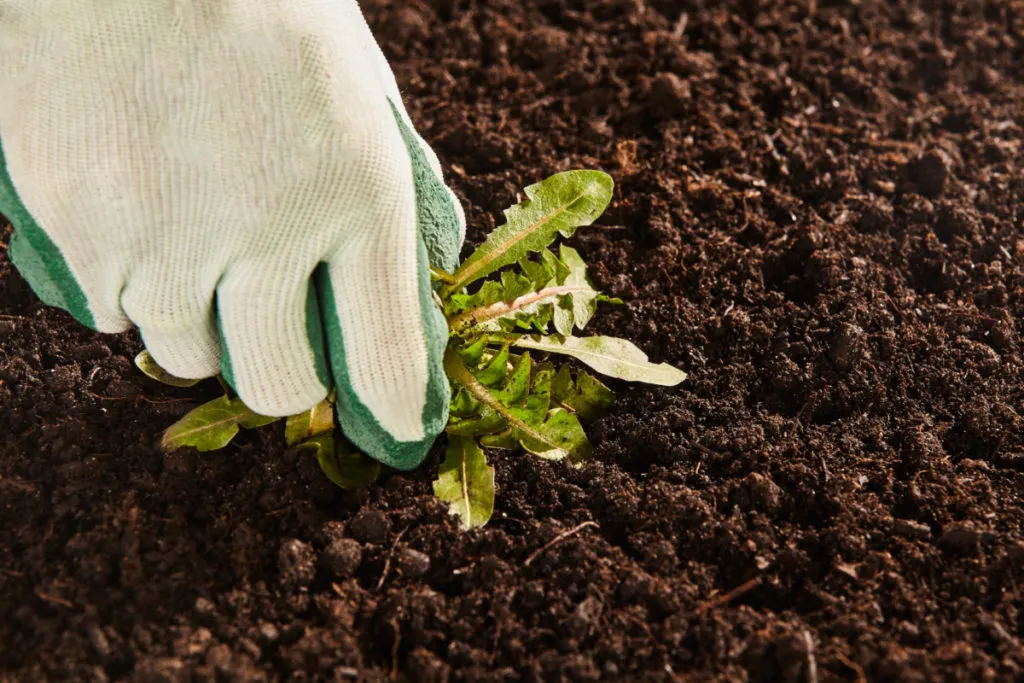
In the natural world, untouched by man, it is very rare to find patches of bare soil that stay bare for long. So why do so many gardeners persist in leaving bare soil?
In nature, especially in temperate climate zones, pioneer plants will quickly colonise bare areas of soil.
When it comes to your garden, what that means, in essence, is that leaving bare soil is an invitation to weeds!
In a low maintenance garden, we definitely want to avoid having to weed.
So we should make sure that we avoid bare soil whenever possible. You’ll pick up more tips about how exactly to cover it through the rest of this article.
3. Choose the Right Plants for the Right Places
Another very important lesson that nature can teach us is that plants will thrive where they are meant to thrive.
In nature, you would not find, for example, a bog plant popping up in a very dry and hot place. Nor would you find a desert plant in a damp and shady spot.
It may sound obvious. But too many gardeners make the mistake of trying to place plants in locations with completely the wrong conditions for them.
To keep your garden running smoothly, with as little input from you as possible, it is vital to choose the right plants for the right places.
Let Nature Reign
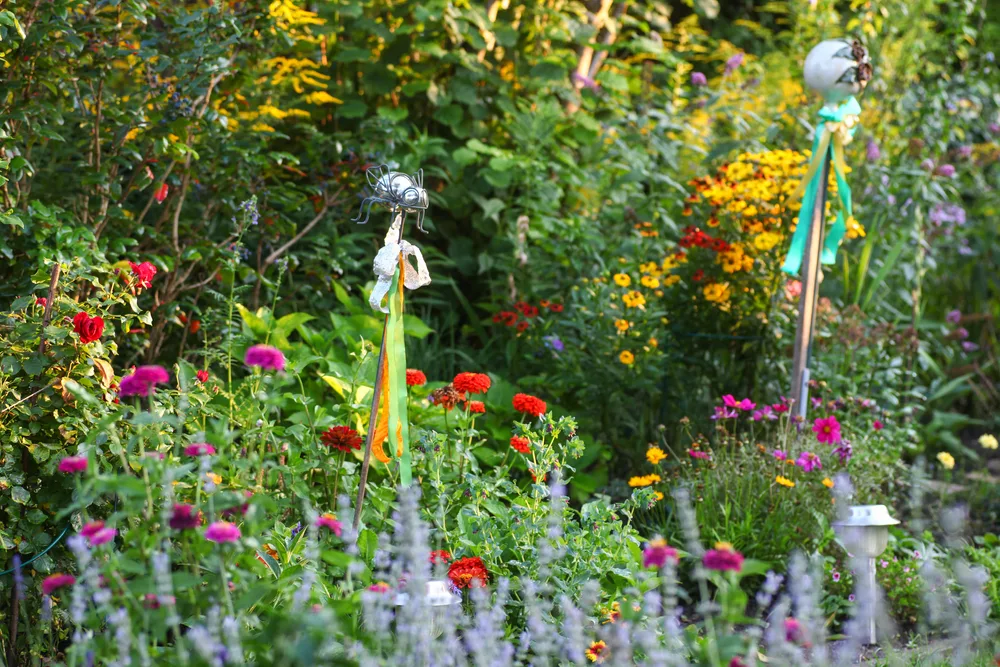
A lot of the work in a more traditional garden involves fighting back nature – trying to battle with it or compete with it in some way.
But in a low maintenance garden, we must work with nature – working in harmony with it so it helps us reach our goals. When nature wins, we all win too.
So here are some tips to help you let nature reign in your garden:
4. Increase Biodiversity as Much as Possible
Many of the time-consuming challenges in a garden involve trying to manage problems with pests and disease.
The very best way to combat these challenges is to garden organically, and to increase biodiversity as much as possible.
The more different plants you grow, the more beneficial interactions between different species you can create. Plants will ‘help’ one another, so you will have to do less to help them yourself.
The more beneficial connections are formed between plants in your garden, the more stable the system will be. This means that you will form a resilient garden that can often be left more or less to its own devices.
A mono-crop like a perfect grass lawn will be far more labor intensive to maintain than polycultures of perennial plants, wildflower meadows, or even annual crops.
Many people planning a low-maintenance garden make the mistake of reducing rather than increasing the number of plants they grow. They de-green a space and install large areas of hardstanding or man-made structures.
But a truly sustainable and long-lasting low maintenance garden will always include as many plants as possible.
5. Be Relaxed About Weeds
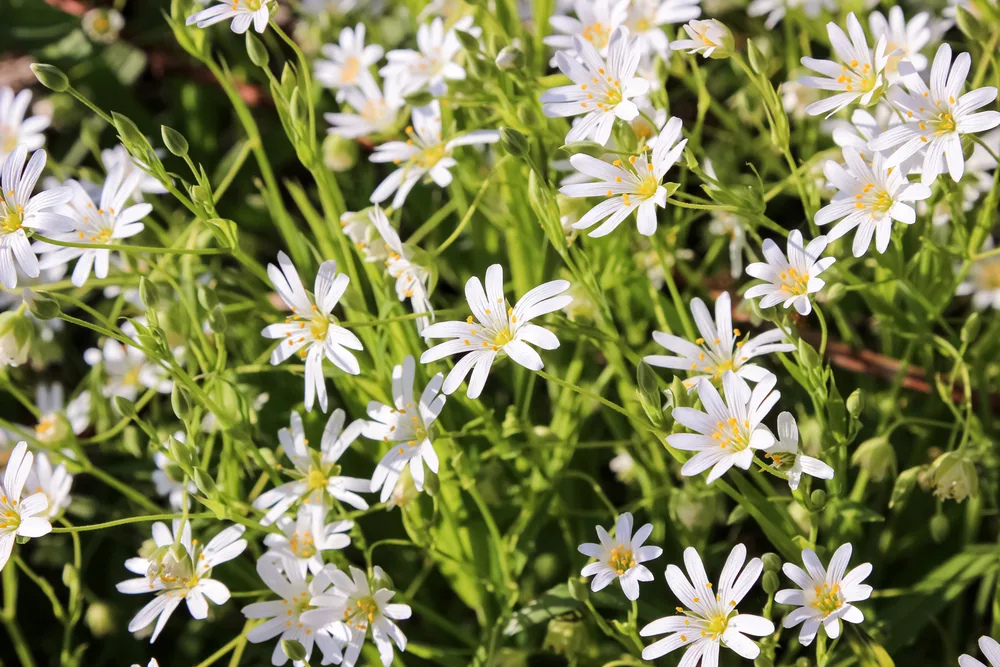
Weeds are also part of nature’s biodiversity. So in a low-maintenance garden, we should be more relaxed about weeds.
Remember, weeds are often simply plants that thrive in a given situation. That is why they can sometimes have a tendency to take over.
Often, what we call weeds are often just the right plants for the right places.
Of course, there will still be times when we don’t want them in a particular area, because we want to space for more useful or productive plants. (We’ll talk about how to cut down on weeding a little later.)
But you should be relaxed about a few weeds in your low maintenance garden. They may actually be useful additions.
6. Welcome in Wildlife
One way that weeds here and there might benefit your garden is by attracting beneficial wildlife.
Remember, increasing biodiversity does not just apply to plants. It applies to other forms of life too.
Welcoming wildlife into your garden can make your life easier. Diverse wildlife will help keep pest species in check, and keep the ecosystem in balance.
When you welcome wildlife, you are welcoming a host of helpers into your garden.
With these helpers doing their jobs – there will be less work for you to do.
Think Long Term
When creating a low-maintenance garden, many people make the mistake of thinking short term.
They pop in plants or areas of paving or decking without thinking about what will be involved in maintaining the space long-term.
Here are some more tips to help you plan a low-maintenance garden that can thrive over the long term:
7. Take Care of the Soil
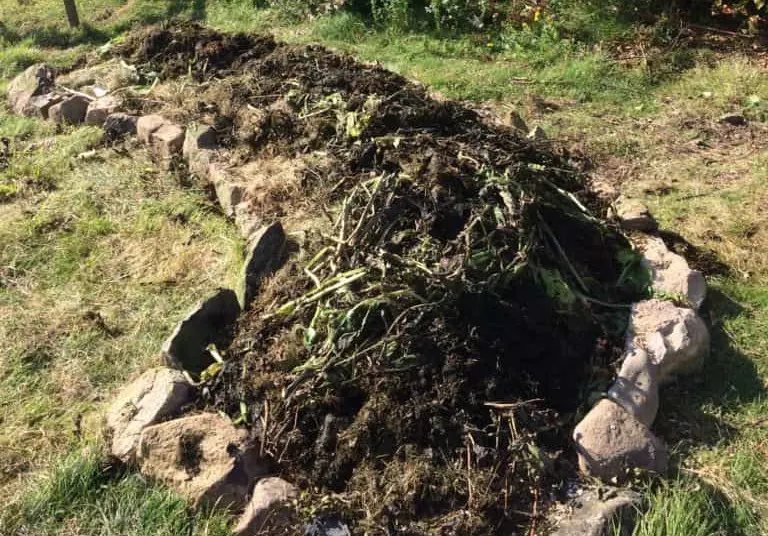
A garden with unhealthy or degraded soil will always be harder and more time consuming to maintain than one with healthy soil.
A little work upfront to take care of and improve the soil can save a lot of work in your garden later on, and long term.
No matter what kind of low maintenance garden you want to create, the soil should be a number one concern.
Implementing ‘no dig’ gardening is one way to ensure healthy soil, right from the start.
If you are making new growing areas for your low maintenance garden, sheet mulching, making a ‘lasagna’ garden bed, or employing hugelkultur methods can all be great ideas.
All generally involve less work than digging or double digging a bed in a more traditional way.
8. Think About Water
Another vital thing to consider in a low maintenance garden, right from the start, is water.
You will want to create a garden that can thrive independently, or with little intervention from you.
To do so, it is important to consider how water travels across your land, how it flows through the soil. You need to think about how natural rainfall and ground water can be slowed, directed and stored.
The more you can make use of natural rainfall and water on your property, the less additional watering will be required from you. The installation of rainwater harvesting systems to collect water from the roof of your home or other structures is one top priority.
Other things to consider are basins, swales, ponds and other earthworks.
Shaping the land can often help you make a garden that can not only survive but also thrive with little human intervention.
Again, when it comes to water, a little work up front will save a lot of time and effort later.
9. Plant Perennials
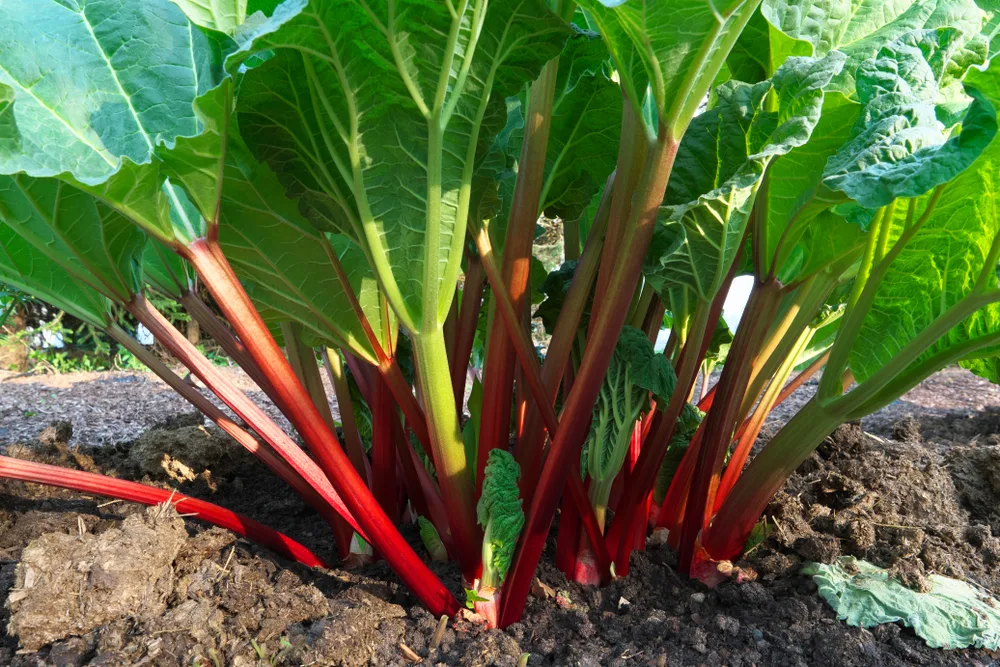
You may still wish to grow some traditional annual fruits and vegetables.
But if you really have little time to spare, perennials are almost always the best long-term options for a low maintenance garden. You may be surprised by the range of perennial food-producing plants that you can grow.
As mentioned above, a forest garden can be the ultimate low-maintenance food producing space.
A forest garden will usually include a wide range of perennial trees and plants, including:
- Fruit and nut trees, and perhaps even trees with edible leaves.
- Fruiting canes and fruit bushes.
- Herbaceous perennials – including plenty of perennial vegetables. Examples of perennial vegetables include: rhubarb, globe artichokes, sorrel, Good King Henry, everlasting cabbage, Daubenton’s kale, Nine-star perennial broccoli, sea beet, fat hen, chickweed, hostas and many more delicious low-maintenance options.
- Perennial root crops and bulbs, such as Jerusalem artichokes, skirret, elephant garlic, Welsh onions, bunching onions, wild garlic and more.
Set up a system with these, and plenty of other perennial plants and you can enjoy a wide range of food while expending far less time and effort in your garden.
10. Build Feedback Into Your System
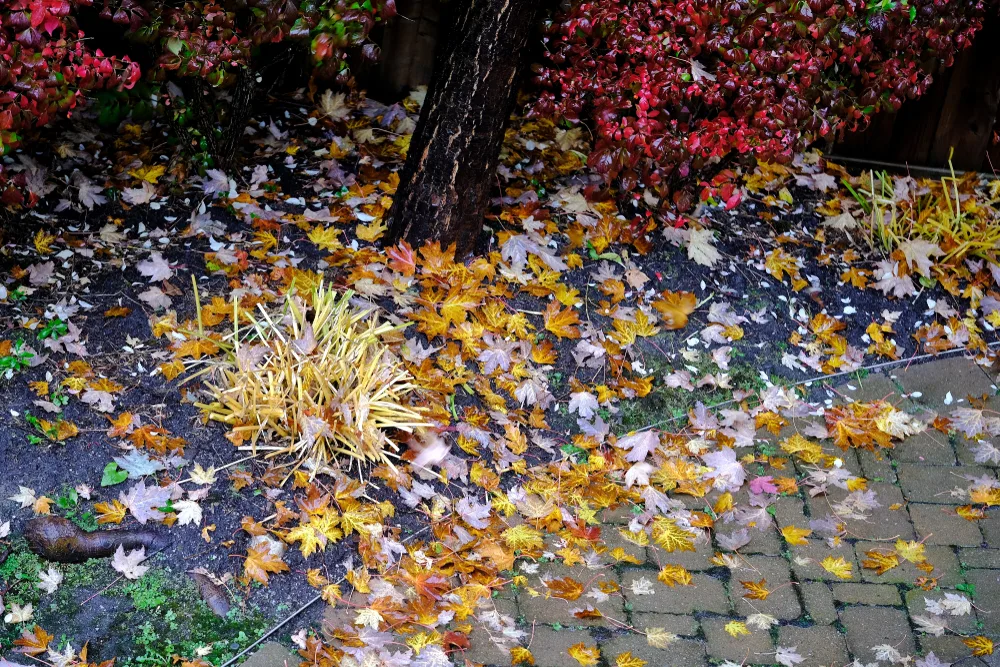
In order to ensure that your low maintenance garden can sustain and support itself over time, you will need to think about how nutrients will be fed back into the system.
Here, again, you can really begin to see the benefits of a forest garden as a low-maintenance garden option.
Deciduous trees and shrubs in your forest garden will naturally drop their leaves in fall.
The well-cared for soil ecosystem below will allow those nutrients to naturally return the nutrients they contain to the soil, completing the natural cycles and feeding the plants.
Chopping and dropping certain plants can aid this cycle, but ultimately, a mature food forest will largely be a closed loop system that needs little additional input from you.
If you do want to grow annual crops, it is possible to reduce the effort involved in closing the loop in a range of different ways. Composting food scraps and other organic waste takes some work – but there are ways to make this process quicker and easier.
We’ll explore these a little later in this article. Again, a little work and effort early on to establish feedback systems can save time and effort as your garden grows over time.
Consider Your Particular Site and Needs
There is no ultimate solution for a low maintenance garden. What works well in one climate and situation will not necessarily be the best idea in another.
These next tips all involve making sure that you consider your particular site and your own particular needs:
11. Don’t Take a ‘Once Size Fits All’ Approach
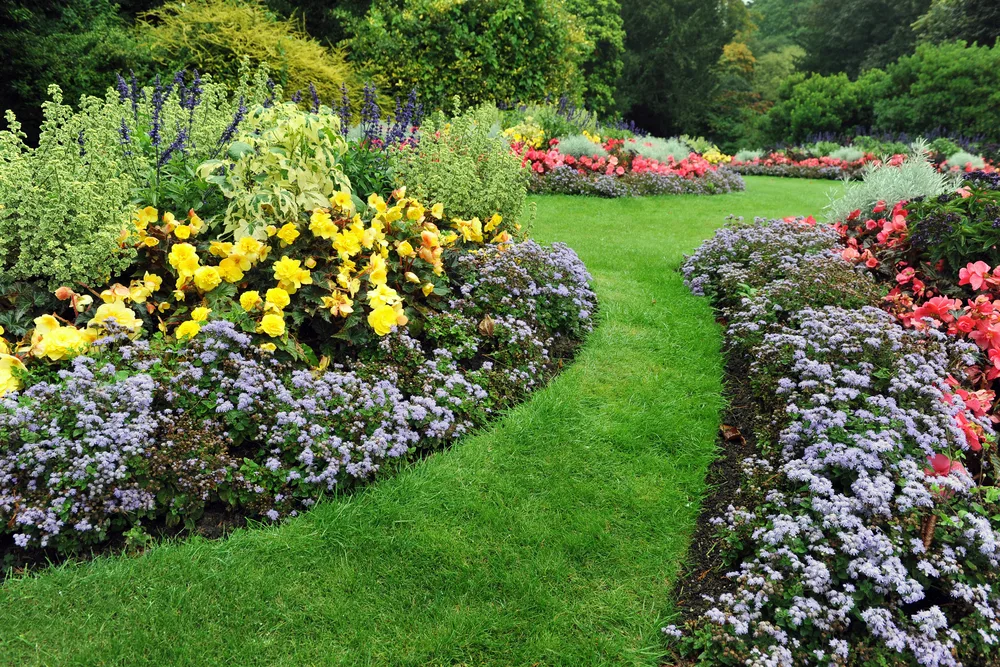
It is very important not to design your low maintenance garden from a book, or on general advice alone. You should always also be sure to think about the characteristics and limitations of your particular location and your particular garden.
A low maintenance garden will always be designed with the climate in mind. It is also increasingly important to consider how your garden’s needs and health will vary as the climate changes over time.
Designing a climate resilient garden from the outset will help you avoid problems and time-consuming issues over time.
It is important to think not only about plants, water and soil, but also other elements in your garden – from paths and paving, to outside recreation areas.
And you should also consider any structures too.
Having all the right elements in the right places can make a big difference to how easy it is to maintain your garden.
Of course, your own particular character and preferences will also come into play.
Low maintenance can mean different things to different people. Some people are happy to spend some time growing annual crops in an easier way, for example, while others really want to take a completely hands-off approach.
Some people are focussed on gaining food, while others may just want a beautiful low-maintenance space.
Think about your own goals and preferences when coming up with your design.
12. Zone Your Site To Make Maintenance Quicker and Easier
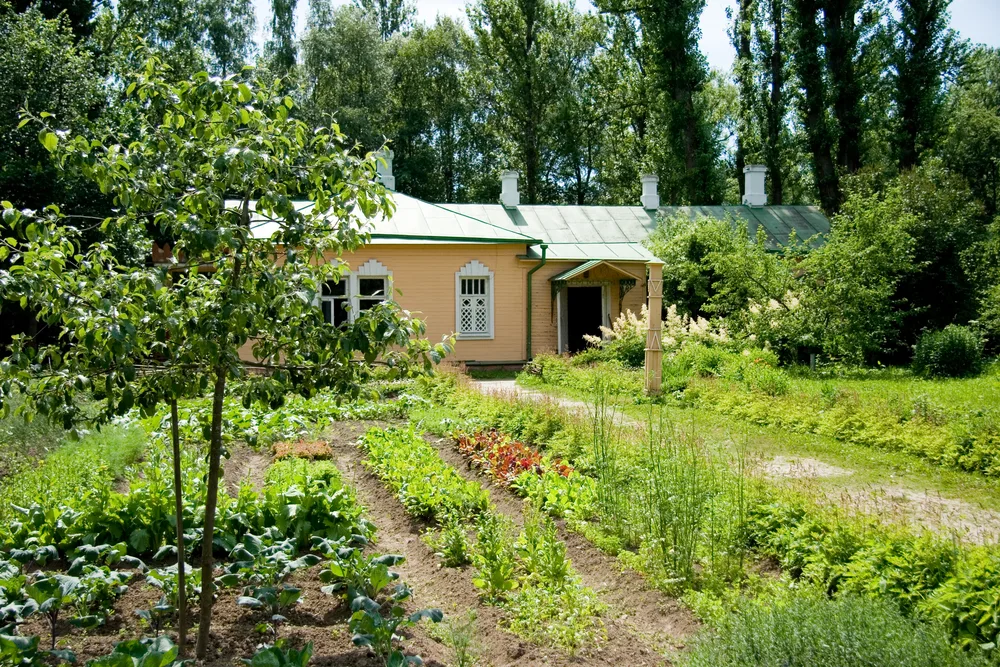
The concept of zoning is all about making sure your garden requires minimal time and effort from you.
No matter how large or small your garden may be, zoning can help you to decide where to position each of the elements to make things easier.
Zone zero is the centre of operations – generally your home. Zone one, generally closest to your home and easiest to get to, should be for parts of the garden you need to visit most often.
This may include an annual vegetable garden and herb garden if you decide to include them. Having them as close to your home as possible will make them easier to maintain.
You should also make sure compost heaps and other elements needs for this zone’s activities are close by.
Zone two will include elements that you visit a little less often. A forest garden would usually be in this zone.
Then, moving out from there, you may also have zone three, for farm or commercial crops; zone four, for larger livestock, and zone five – for wildlife zones and untamed corners.
13. Make Sure Access is Easy
Access is another important element in a low-maintenance garden.
The harder your garden zones are to access, the less inclined you will be to maintain them, and the more effort and time that will involve. Think carefully about how you and other people will move around the garden.
Patterns of movement will help you determine where pathways should be placed.
To save time, it is usually best to keep the distances between various elements as short and straight as possible. But bear in mind that the path of least resistance is best, so do not force straight lines where a detour is the easier option.
Make sure that all your paths are wide enough. It will also be important to think carefully about what they are made from.
More durable pathway options like stone, brick etc. will usually be the best choices for a garden that requires less upkeep over time.
Speed Up Processes & Make Maintenance Easier
Finally, let’s take a look at some of the ways that we can speed up processes and make maintenance easier in your garden:
14. Harness Some Help With Composting
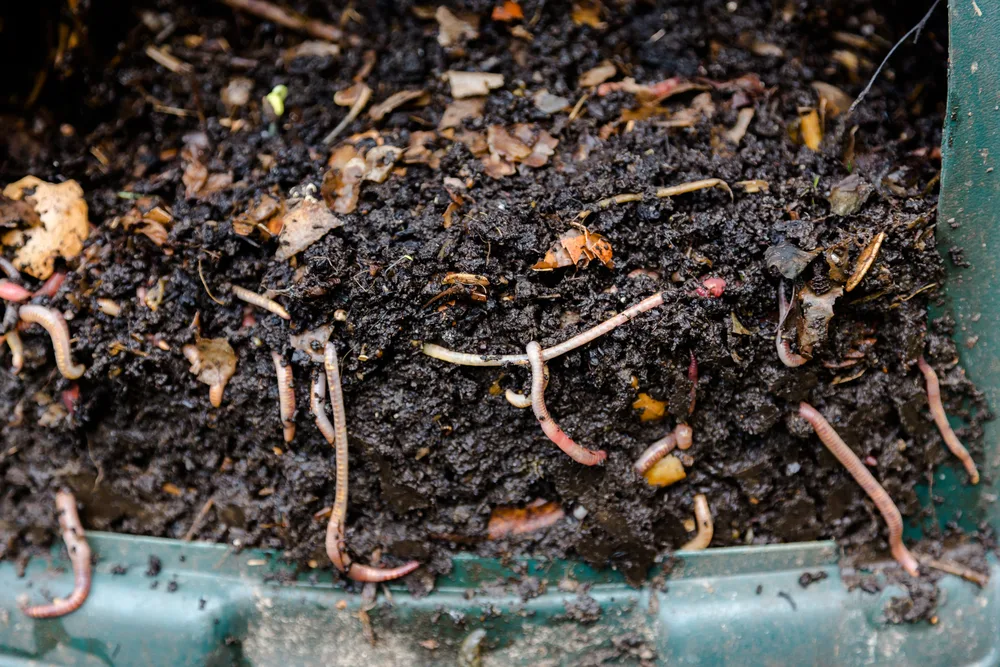
Whether or not you are growing your own food, composting can be important for returning nutrients to the soil. It can also help you live more sustainably and reduce food waste.
Fortunately, composting at home can be quicker and easier than you might imagine.
There are a number of different routes you can take with home composting.
But for a low-maintenance garden, harnessing some help with composting can be a good way to go. The helpers in this case are not people, but rather wriggling worms!
Vermiculture composting is something that you can do inside or outside your home.
Set up the system and the worms make your life easier by helping to break down food waste, and providing you with compost to feed soil and plants.
They also help by providing a liquid feed to keep your garden growing strong.
15. Cut Down Weeding Required
No matter what kind of low maintenance garden you decide to make – you do not need to be a slave to weeding.
You can opt for a forest garden, perennial beds, or a lower maintenance annual growing area. Whichever option or options you choose, weeds should not be viewed as the enemy.
As mentioned above, weeds can actually be beneficial – and you should keep some around.
But you can also make weeding less of a chore by:
- Mulching around your plants with a good quality organic mulch to suppress weed growth.
- Avoiding tilling or digging and unearthing weed seeds to germinate in the sun.
- Planting densely and companion planting to avoid bare soil and reduce weeds.
- Employing ‘casual weeding’ and grabbing a weed or two whenever you pass by.
- Harvesting weeds to eat them, or use them in other ways around your homestead.
16. Choose the Right Tools
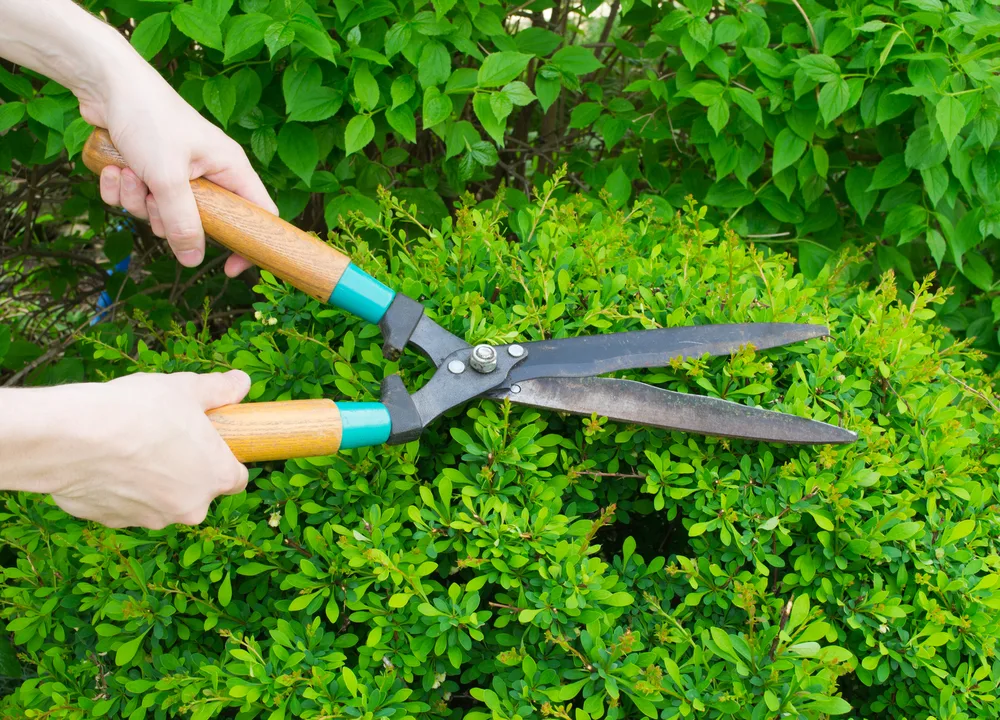
Having the right tools can make maintaining any garden easier.
In a low-maintenance garden, there will still inevitably be a few garden jobs to do – they just won’t be as hard work, or take as long to do. You can cut down the time taken for these jobs by choosing tools to make your life easier.
For example, if you have fruit trees, you can make your life easier come harvest time with a fruit picker.
Chopping and dropping plants in a forest garden, pruning, and other jobs will be easier with a good pair of garden shears.
Choose tools carefully and you will find your garden, any garden, easier to maintain.
17. Consider Raised Beds For Easier Tending and Harvesting
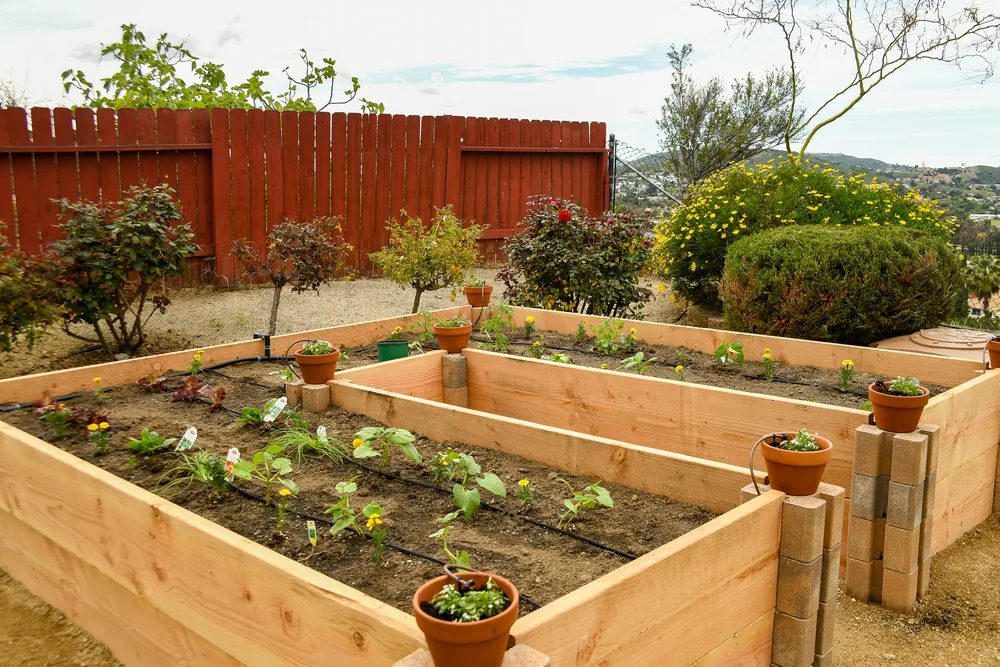
In ground growing is generally a lower maintenance choice. Additional watering needs will be lower if you grow at ground level, and there may be less work involved in making the growing areas in the first place.
But if you do decide that you would like to make annual vegetable beds, or even smaller perennial beds, then raised beds can make your life easier in certain ways.
Raised beds can make tending and harvesting from your garden easier – saving you time and effort that may make up for time you may have to spend on watering.
Here’s some DIY raised bed ideas, and some ready-made raised beds to try, too.
18. Consider Automating Watering
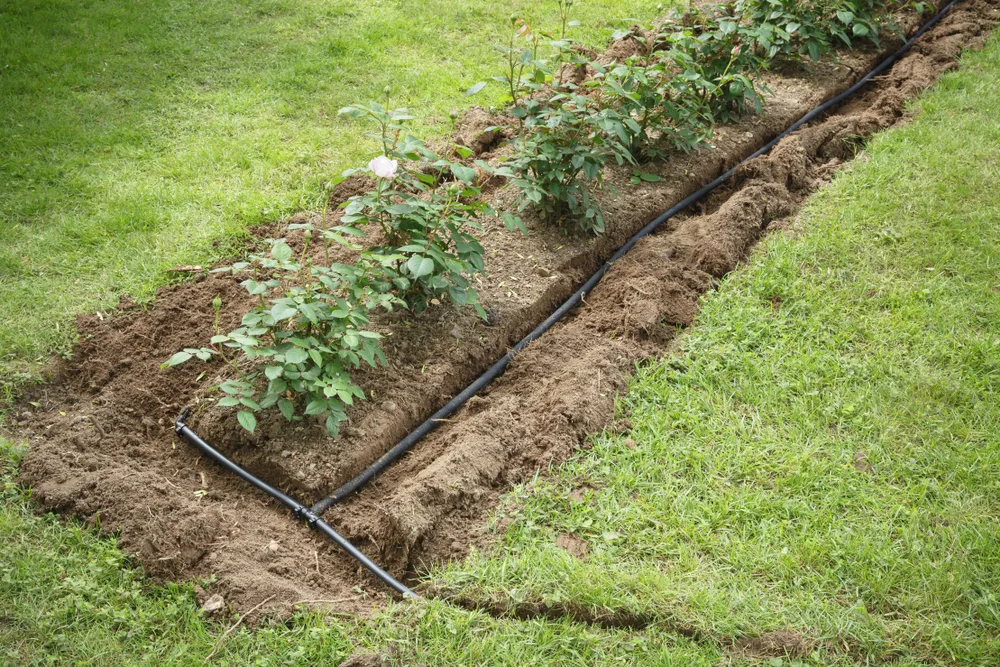
In a low maintenance garden, watering in dry weather can be made a lot easier with automated watering systems. As mentioned above, you should already have considered where the water will come from.
You should have an idea of how to harness and manage rainfall and water flow in your garden.
You may already have thought about employing earthworks like swales to collect water and direct it to where it is needed.
But there are also a number of ways to make sure your garden can essentially water itself.
You could consider:
- Wicking beds, or drip feed irrigation systems attached to rainwater harvesting systems. By installing a valve on the system, you can determine when water flows. By creating reservoirs or water storage, and opening valves, it is possible to create a garden that can take be supplied with water while you are busy or away from home.
- Using water globes, clay pots or containers of water placed upright in the soil. These can be positioned to slowly release water for plants while you are busy or away from home.
19. Consider Gardening Without Soil
An initial investment of time and effort could allow you to come up with a rather different sort of low-maintenance garden solution.
In areas with very dry or challenging growing conditions, hydroponic or even aquaponic systems could provide a solution.
Such systems do, of course, take more effort than other garden systems to maintain – unless, that is, you find yourself in a very challenging environment.
Once set up and established, growing food without soil may be the path of least resistance in certain settings.
As mentioned above, a low-maintenance garden is all about context.
20. Plan Well For a Staggered Harvest
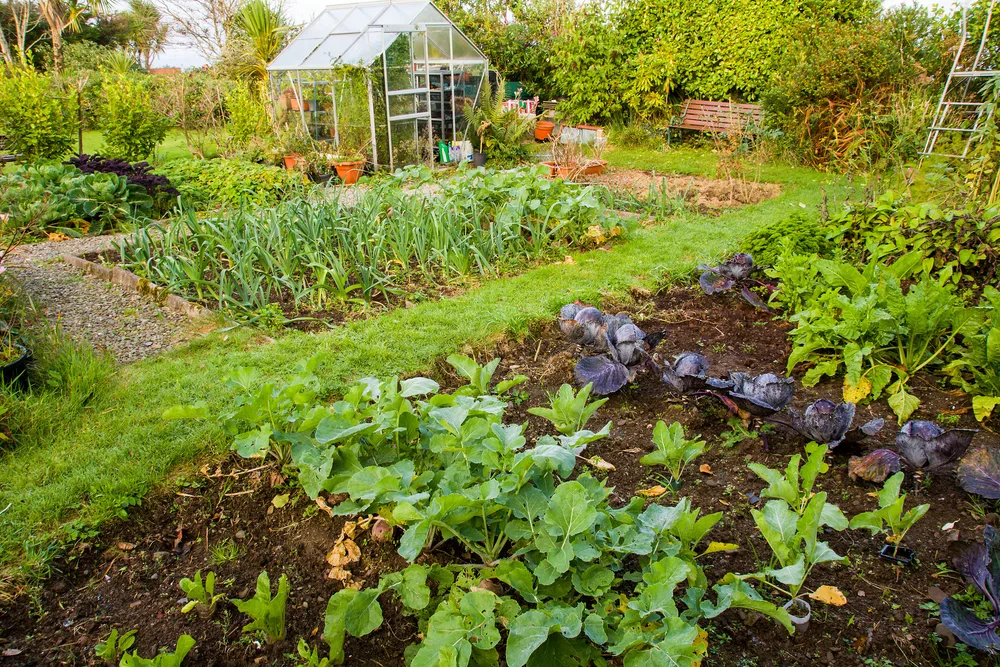
No matter what kind of low maintenance garden you create, one final thing to consider is harvesting.
In a low maintenance forest garden – the easiest type of food producing garden for many settings – harvesting will be the thing that takes up the most time.
Even if you are only harvesting cut flowers from a perennial border, it will take a little time and effort.
So one final thing to think about when planning your low maintenance garden is when, how and how much you will harvest. The best way to make sure you expend as little time and effort as possible is to plan well.
Planning what you plant can help you ensure that you do not have a hectic time at one particular time of year.
Plant edible options and plants for other yields that can be harvested little and often throughout the year.
Plan well for a staggered harvest of whatever you grow.
Remember, a low maintenance garden does not have to be boring. And it could still be eco-friendly, and meet many of your needs.
So don’t pave over that yard just yet! Consider the tips above and think about making your low maintenance garden a beautiful and productive space.

Get the famous Rural Sprout newsletter delivered to your inbox.
Including Sunday musings from our editor, Tracey, as well as “What’s Up Wednesday” our roundup of what’s in season and new article updates and alerts.

